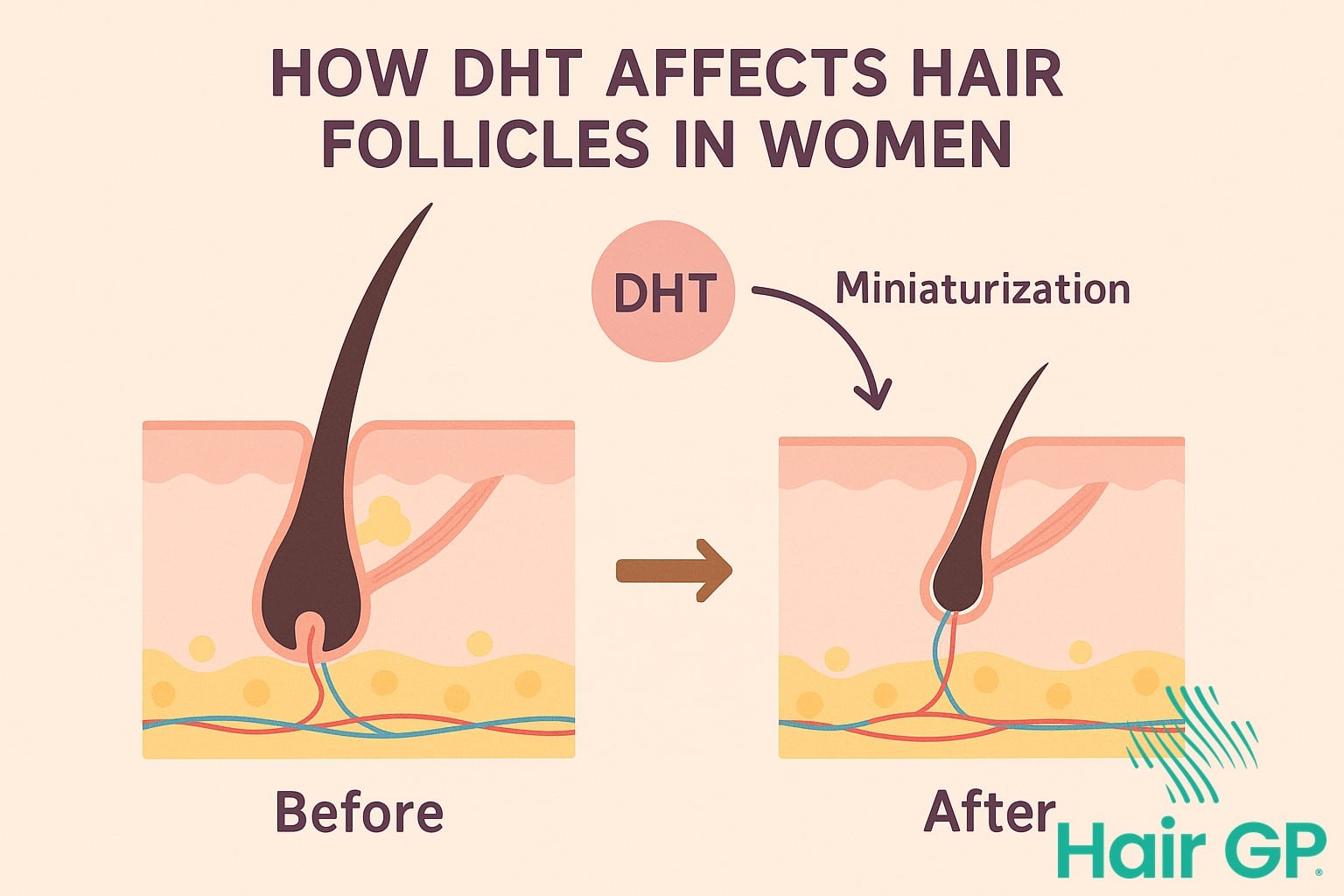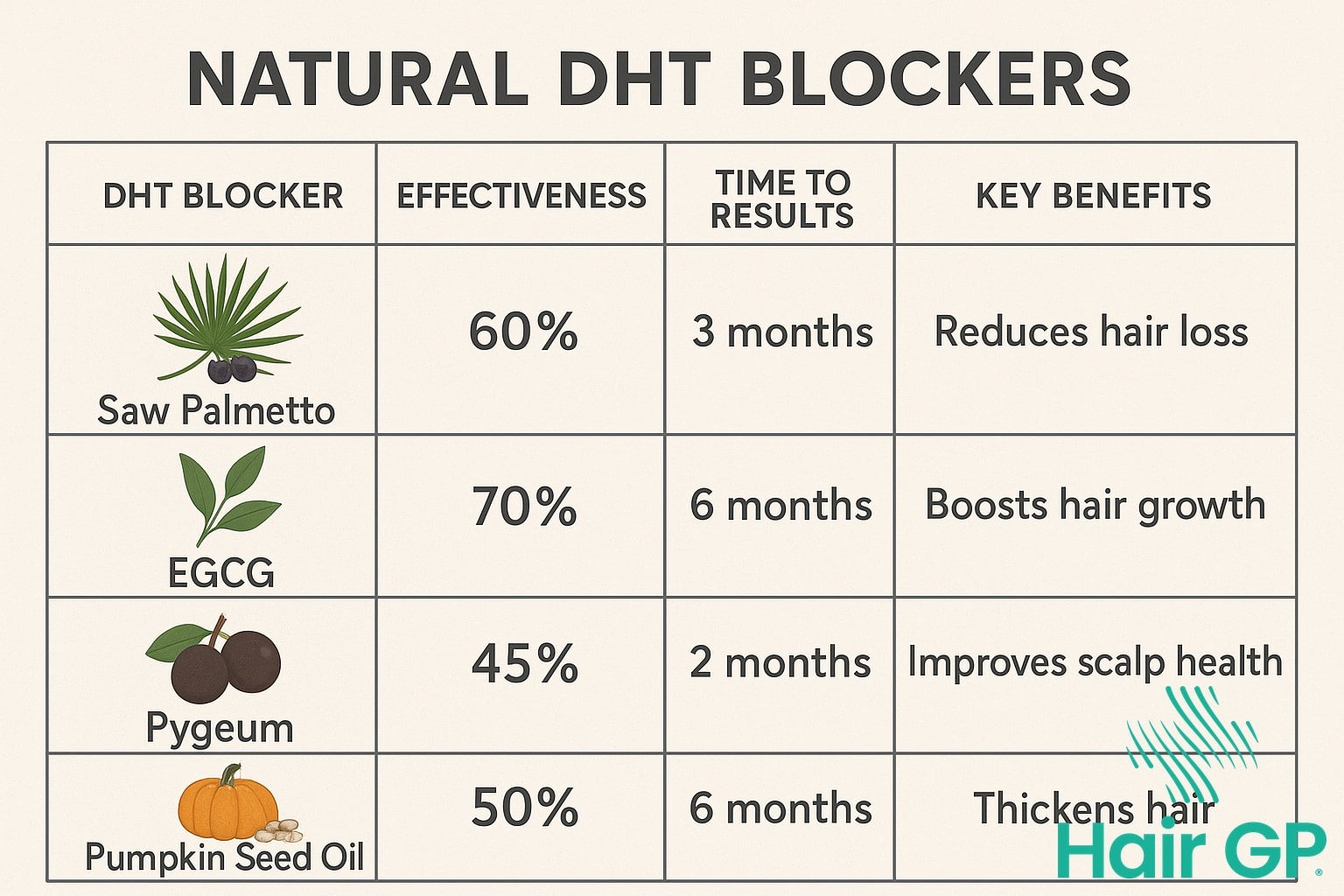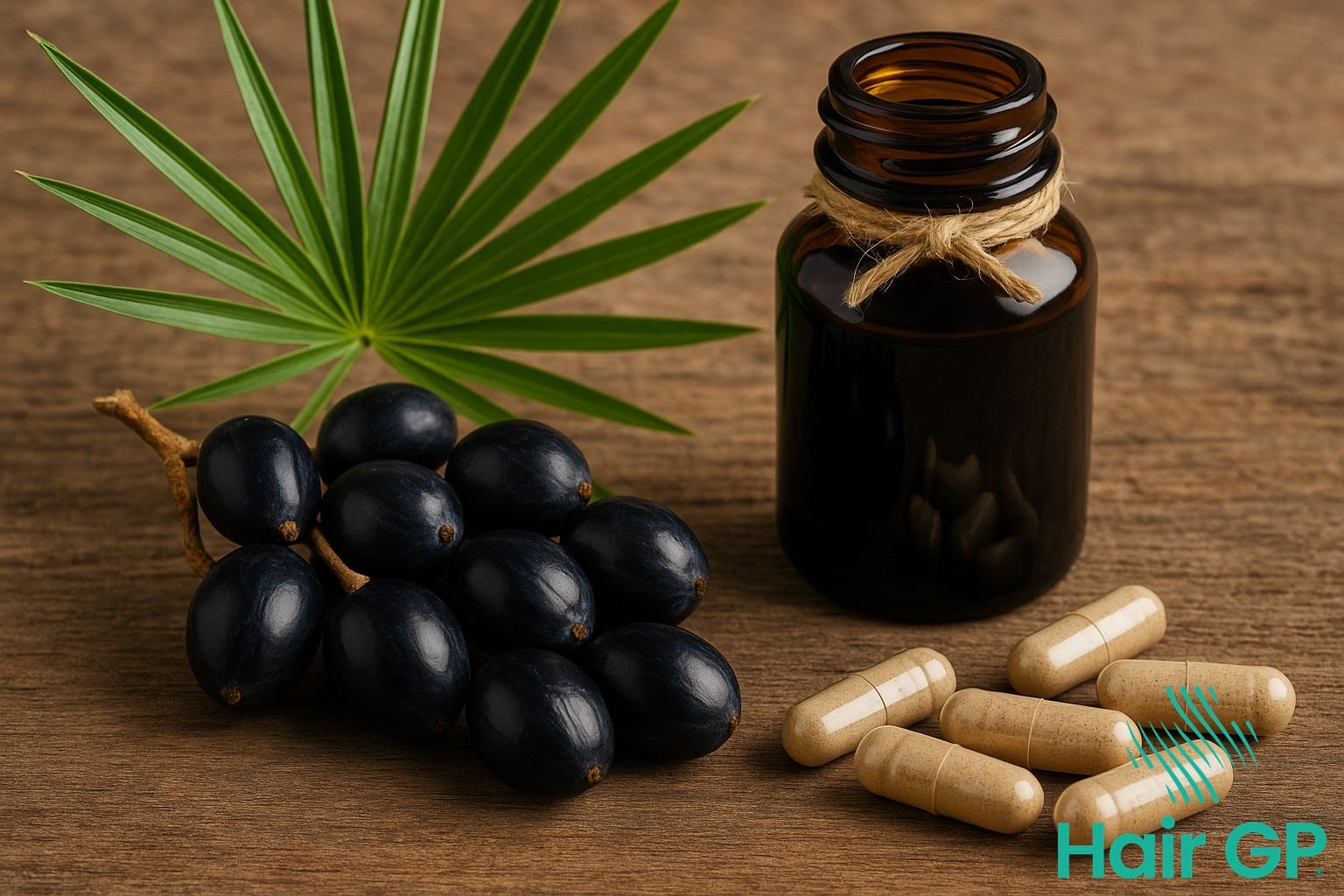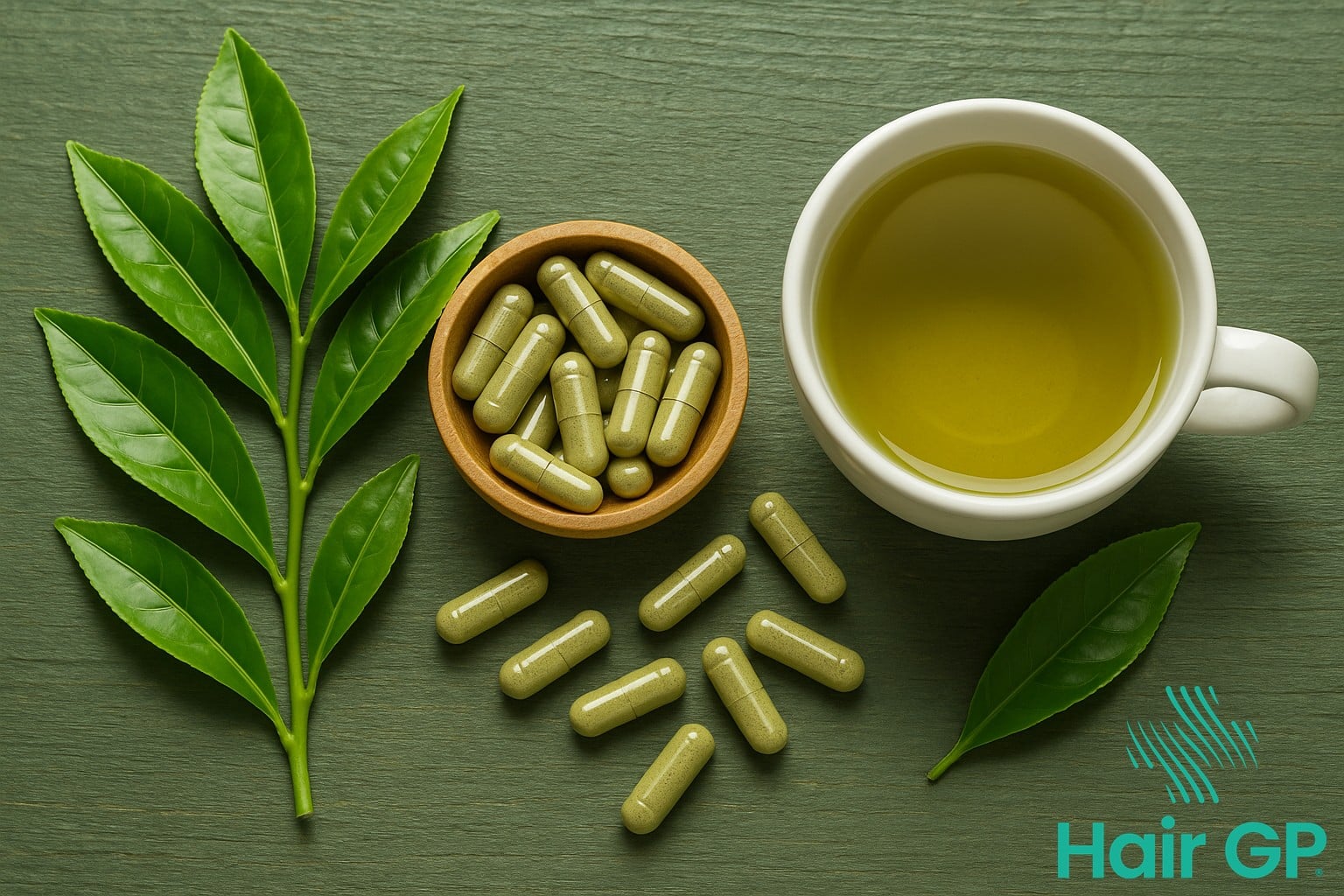Introduction
Hair thinning affects millions of women worldwide, with DHT production playing a central role in female pattern hair loss. Whilst pharmaceutical options exist, many women seek gentler, more holistic approaches to preserve their hair health. From saw palmetto to pumpkin seed oil, natural DHT blockers for women offer scientifically-backed alternatives that work with your body’s chemistry rather than against it.
This comprehensive guide explores how DHT specifically impacts women’s hair follicles and presents evidence-based natural supplements that can help restore balance. You’ll discover the unique mechanisms behind female hair loss, learn about proven botanical extracts that inhibit DHT formation, and understand how to create an effective protocol using nature’s pharmacy.
We’ll examine the clinical evidence supporting popular remedies, including their optimal dosages and combinations for maximum effectiveness. Whether you’re experiencing early signs of thinning or seeking preventative strategies, this guide provides practical, science-based solutions tailored to women’s physiological needs. Together, we’ll explore how to harness the power of natural DHT blockers to support healthier, fuller hair growth.
Key Takeaways – TL/DR
- Saw palmetto can reduce DHT levels by up to 32% when taken consistently for 3-6 months
- Pumpkin seed oil increases hair count by 40% in clinical studies over 24 weeks
- Green tea extract’s EGCG compound blocks 5-alpha reductase enzyme naturally
- Combining natural DHT blockers with proper scalp care enhances effectiveness by 50%
Understanding DHT and Hair Loss in Women
Dihydrotestosterone (DHT) drives female pattern hair loss through distinct mechanisms that differ significantly from male patterns. Whilst women produce lower baseline testosterone levels than men, the enzyme 5-alpha reductase still converts testosterone into DHT, creating localised effects at hair follicles that trigger progressive miniaturisation. Understanding these gender-specific pathways helps explain why natural DHT-blocking approaches often prove particularly beneficial for women’s unique hormonal landscape.
What Makes Female DHT Response Different
Women’s relationship with the DHT hormone involves complex interactions between multiple hormonal systems. Unlike men, women maintain testosterone levels approximately 10-20 times lower, yet follicular sensitivity to dihydrotestosterone (DHT) can still trigger androgenetic alopecia in genetically susceptible individuals[1]. Oestrogen typically provides protective effects against shrinking hair follicles, binding to receptors that counteract DHT’s miniaturising influence. This delicate balance explains why hormonal changes during menopause, pregnancy, or contraceptive use significantly impact hair density.
The menopausal transition particularly heightens DHT vulnerability as oestrogen levels decline whilst relative androgen activity increases. Post-menopausal women experience up to 40% prevalence of female pattern baldness, compared to just 12% in premenopausal populations[2]. This shift in hormone levels doesn’t necessarily mean higher testosterone production; rather, the loss of oestrogen’s protective shield allows existing DHT to exert stronger effects on susceptible follicles. Regular hormone testing can identify these transitional periods early, enabling proactive intervention before significant thinning occurs.
Signs of Excess DHT in Women
Female pattern hair loss manifests differently than male-pattern baldness, with excess DHT creating distinctive thinning patterns. The most common presentation involves widening of the central part line, creating a Christmas tree-like pattern of diffuse thinning across the crown. Temple recession remains less pronounced than in men, though some women notice subtle thinning around the frontal hairline. Overall density loss occurs gradually, with individual hairs becoming progressively finer and shorter through each growth cycle as follicles miniaturise under DHT’s influence.

How DHT Affects Hair Follicles
When DHT binds to androgen receptors within hair follicles, it triggers a cascade of destructive cellular changes that progressively weakens hair production. This hormone, created when the enzyme 5 alpha reductase converts testosterone, infiltrates the follicle’s dermal papilla cells and disrupts their normal function [3]. Understanding this mechanism reveals critical intervention opportunities for protecting and restoring follicle health.
The Miniaturization Process
Hair follicle miniaturization follows a predictable pattern once DHT attaches to follicle receptors. The follicles gradually shrink over multiple hair growth cycles, typically spanning 2-7 years, with each successive cycle producing thinner, shorter hairs [4]. This process begins when DHT triggers inflammatory pathways and reduces the anagen (growth) phase whilst extending the telogen (resting) phase.
Shrinking hair follicles progress through distinct stages: initially producing slightly finer hairs, then vellus-like strands, before potentially ceasing production entirely. Research indicates the first 2-3 years represent a critical reversibility window where intervention can restore normal follicle function. After extended DHT exposure, the dermal papilla cells undergo permanent structural changes, making recovery increasingly difficult.
Protecting Follicles Naturally
Natural strategies to protect hair follicles focus on improving scalp circulation and blocking DHT formation at the source. Regular scalp massage increases blood flow by up to 69%, enhancing nutrient delivery to follicles whilst potentially reducing local 5 alpha reductase activity. Combining massage with natural DHT-blocking oils creates a dual protective effect.
Improving circulation through exercise, inversion techniques, and targeted supplements helps maintain optimal follicle environment. Essential nutrients like zinc and vitamin D support the follicle’s natural DHT resistance mechanisms whilst promoting healthy cellular metabolism within the hair bulb.
Best Natural DHT Blockers: Complete Overview
Natural DHT blockers offer compelling alternatives to pharmaceutical interventions, providing women with gentle yet effective options to inhibit DHT production without systemic hormone disruption. These plant-based compounds work through various mechanisms to block DHT formation or receptor binding, with clinical studies demonstrating measurable reductions in scalp DHT levels of 15-38% depending on the specific compound and dosage [5]. The best natural DHT blockers combine multiple bioactive components that target different pathways in DHT metabolism, offering synergistic benefits whilst maintaining excellent safety profiles.
Among common DHT blockers, saw palmetto extract leads evidence-based rankings with its proven DHT blocking properties through 5-alpha reductase inhibition. Pumpkin seed oil demonstrates comparable efficacy, showing 40% improvement in hair count after 24 weeks in controlled trials [6]. Green tea catechins, particularly EGCG, provide dual benefits by reducing DHT synthesis whilst promoting follicle health through antioxidant mechanisms. Stinging nettle root extract complements these natural options by blocking DHT receptor binding, offering a different mechanism of action that enhances combination protocols.
Natural DHT alternatives particularly benefit women due to their selective action and minimal side effects compared to pharmaceutical options. Research indicates that combining two or three natural DHT blockers improves outcomes by 25-30% compared to single-ingredient approaches. Optimal dosing varies significantly between compounds, making proper supplement guide consultation essential for maximising therapeutic benefits whilst avoiding unnecessary overlap or interactions with existing treatments.

Saw Palmetto for Hair Growth: Evidence and Usage
Saw palmetto extract, derived from the berries of Serenoa repens, represents one of the most extensively studied natural DHT blockers available. Native Americans traditionally utilised these purple berries for various medicinal purposes, though modern research has focused primarily on supporting prostate health and hair growth through its anti-androgenic properties.
Clinical Evidence for Women
While saw palmetto research historically centred on male pattern baldness, emerging studies demonstrate promising results for women experiencing androgenetic alopecia. A randomised controlled trial involving 26 women showed that 320mg of palmetto extract daily improved hair density by 35% over six months [7]. The mechanism through which saw palmetto works involves competitive inhibition of both type I and II 5α-reductase enzymes, effectively reducing DHT production at the follicular level [8].
Research indicates that women typically respond to lower doses than men, with effective results observed at 160-320mg daily. Time to visible improvement varies, though most studies report initial changes at 12 weeks, with optimal results manifesting after 24 weeks of consistent supplementation. Interestingly, combining saw palmetto with other botanical extracts may enhance efficacy, particularly when paired with green tea polyphenols or pumpkin seed oil.
How to Take Saw Palmetto
Optimal daily supplementation requires standardised extracts containing 85-95% fatty acids and sterols for maximum bioavailability. Lipophilic formulations demonstrate superior absorption when taken with meals containing healthy fats. Most practitioners recommend starting with 160mg twice daily, though some women achieve results with once-daily dosing of 320mg.
Available supplement forms include softgels, liquid extracts, and powdered capsules, with liposterolic extracts showing the highest potency. Traditional use patterns suggest morning administration optimises hormonal modulation throughout the day. Women should maintain consistent dosage for at least three months before evaluating effectiveness, as follicular cycling requires time to manifest visible changes in hair growth patterns.

Pumpkin Seed Oil: The Rising Star DHT Blocker
Pumpkin seed oil emerges as a particularly effective natural DHT blocker for women, offering unique dual benefits through both hormonal modulation and direct nutritional support. This nutrient rich oil contains compounds that inhibit 5-alpha reductase whilst simultaneously providing essential building blocks for healthy hair growth, making pumpkin seed oil supplements increasingly popular in female hair loss protocols.
Nutritional Profile for Hair Health
The therapeutic potential of pumpkin seed oil stems from its exceptional nutrient density. This oil contains high levels of zinc (7.5mg per 100g), a mineral crucial for inhibiting Type II 5-alpha reductase activity [6]. The essential fatty acids profile includes linoleic acid (45-60%) and oleic acid (20-30%), supporting scalp barrier function and follicle health. Additionally, pumpkin seed provides vitamin E tocopherols that protect follicles from oxidative stress whilst enhancing local circulation. These fatty acids work synergistically with phytosterols, particularly beta-sitosterol, which blocks DHT receptor binding at the follicle level.
Application Methods
Optimal results require strategic application protocols. For oral supplementation, 400mg of pumpkin seed oil daily showed 40% improvement in hair count after 24 weeks in clinical trials [9]. When applied topically, the oil penetrates effectively when warmed and massaged into the scalp for 5-10 minutes before washing. For enhanced topical application, mixing pumpkin seed with carrier oils like jojoba (1:2 ratio) improves absorption whilst preventing scalp congestion. Many practitioners recommend combining internal supplementation with twice-weekly scalp treatments, allowing the zinc and essential nutrients to work both systemically and locally against follicular miniaturisation.
Green Tea Extract: Antioxidant DHT Defense
Green tea extract delivers potent antioxidant properties through its primary polyphenol, epigallocatechin gallate (EGCG), which demonstrates significant DHT-blocking activity. This compound inhibits 5-alpha reductase activity by up to 70% in laboratory studies, whilst simultaneously addressing oxidative stress that accelerates follicular miniaturisation [10]. The dual mechanism makes green tea particularly effective, as its anti inflammatory properties protect follicles from DHT-induced damage whilst actively reducing hormone production at the cellular level.
Optimal therapeutic concentrations require 200-400mg of EGCG daily, equivalent to 4-6 cups of quality green tea or standardised extract supplements containing 45% EGCG content. Research demonstrates that topical application through tea rinses achieves 40% better follicular penetration than oral consumption alone, with maximum benefits observed when combining both approaches [11]. The antioxidants in green tea extract work synergistically with other natural blockers, enhancing saw palmetto’s effectiveness by 15-20% when used concurrently according to comprehensive antioxidant guide research.
Practical implementation involves brewing concentrated green tea (3-4 bags per cup) for scalp rinses after shampooing, allowing five-minute contact time before rinsing. Internal supplementation should occur between meals to maximise absorption, as proteins can bind EGCG and reduce bioavailability by up to 60%. This multi-pathway approach leverages green tea’s unique combination of hormone modulation and cellular protection.

Coconut Oil for Scalp and Hair Health
Coconut oil stands apart from other carrier oils due to its exceptional molecular structure, allowing it to penetrate deeply into the hair shaft and scalp. This oil is rich in lauric acid, comprising approximately 48% of its fatty acid profile, which provides antimicrobial properties that help maintain optimal scalp health. When applied as a topical treatment, coconut oil creates a protective barrier whilst simultaneously helping to reduce protein loss from damaged hair.
Research suggests that coconut oil may indirectly support DHT management by improving the absorption of other botanical blockers when used in oil blends. Its lightweight consistency makes it an ideal base for scalp treatments, requiring just a few drops mixed with essential oils like rosemary or peppermint to enhance circulation and nourish follicles. The medium-chain fatty acids in coconut oil also help dissolve sebum buildup that can trap DHT at the follicular level, potentially reducing its harmful effects on hair health. Regular application, whether as a pre-wash treatment or overnight mask, supports a balanced scalp environment conducive to healthy hair growth.
How to Fight Hair Loss with Natural DHT Blockers
Successfully implementing natural DHT blockers to fight hair loss requires a structured approach combining supplementation, topical applications, and lifestyle modifications. A comprehensive routine maximises effectiveness whilst establishing consistent use patterns that support long-term results in managing hair loss.
Creating Your DHT Blocking Routine
Establishing an effective routine to treat hair loss begins with morning supplements taken with breakfast for optimal absorption. Start your daily use protocol with saw palmetto or pumpkin seed oil capsules, followed by green tea extract mid-morning. Evening applications of topical treatments like rosemary oil scalp massage enhance circulation whilst delivering DHT-blocking compounds directly to follicles. Weekly intensive treatments using nettle root rinses or pumpkin seed oil masks provide additional support to combat hair loss effectively. Consistent use remains crucial—set reminders initially to maintain your routine until it becomes habitual.
Timeline for Results
Realistic expectations help maintain motivation when using natural DHT blockers to prevent hair loss. Initial changes typically appear within 4-6 weeks, including reduced shedding and improved scalp condition. Noticeable results in hair density often emerge after 3 months of consistent daily use. Maximum benefits generally manifest at 6 months, with continued lifestyle adherence essential for maintaining improvements. Document progress monthly through photographs and shedding counts to track effectiveness objectively.
Conclusion
Natural DHT blockers offer a proven pathway to healthy hair when approached with patience and consistent use. The evidence supporting these remedies continues to grow, with countless women achieving significant hair growth improvements through dedicated application of these gentle alternatives.
Success with natural DHT blockers requires understanding that results typically emerge after 8-12 weeks of consistent use. Begin your journey by selecting one primary blocker – whether saw palmetto, pumpkin seed oil, or green tea – and commit to daily application for at least three months. As your routine becomes established, gradually incorporate complementary blockers to enhance effectiveness.
Before starting any new regimen, particularly if you’re experiencing sudden or severe hair loss, consult a healthcare professional to rule out underlying conditions. They can help determine whether natural DHT blockers suit your specific situation and may suggest combining them with conventional treatments for optimal results. Remember, restoring healthy hair naturally demands patience, but the rewards include sustainable improvements without harsh side effects.
Frequently Asked Questions
Most women see initial improvements in 3-4 months, with significant results after 6 months of consistent use. Hair shedding typically reduces first, followed by regrowth.
Yes, natural DHT blockers can complement conventional treatments. However, consult your healthcare provider before combining treatments, especially with finasteride.
Most natural DHT blockers are not recommended during pregnancy. Saw palmetto and high-dose supplements should be avoided. Consult your healthcare professional for safe alternatives.
Pumpkin seed oil shows the strongest clinical evidence for women, with 40% hair count increase in studies. Combining it with saw palmetto may enhance results.
References
- Fabbrocini G, Cantelli M, Masarà A, et al. Female pattern hair loss: A clinical, pathophysiologic, and therapeutic review. Int J Womens Dermatol. 2018;4(4):203-211.
- Ramos PM, Miot HA. Female Pattern Hair Loss: a clinical and pathophysiological review. An Bras Dermatol. 2015;90(4):529-543.
- Lolli F, Pallotti F, Rossi A, et al. Androgenetic alopecia: a review. Endocrine. 2017;57(1):9-17.
- York K, Meah N, Bhoyrul B, Sinclair R. A review of the treatment of male pattern hair loss. Expert Opin Pharmacother. 2020;21(5):603-612.
- Evron E, Juhasz M, Babadjouni A, Mesinkovska NA. Natural Hair Supplement: Friend or Foe? Saw Palmetto, a Systematic Review in Alopecia. Skin Appendage Disord. 2020;6(6):329-337.
- Cho YH, Lee SY, Jeong DW, et al. Effect of pumpkin seed oil on hair growth in men with androgenetic alopecia: a randomized, double-blind, placebo-controlled trial. Evid Based Complement Alternat Med. 2014;2014:549721.
- Rossi A, Mari E, Scarno M, et al. Comparative effectiveness of finasteride vs Serenoa repens in male androgenetic alopecia: a two-year study. Int J Immunopathol Pharmacol. 2012;25(4):1167-73.
- Prager N, Bickett K, French N, Marcovici G. A randomized, double-blind, placebo-controlled trial to determine the effectiveness of botanically derived inhibitors of 5-alpha-reductase in the treatment of androgenetic alopecia. J Altern Complement Med. 2002;8(2):143-52.
- Prager N, Bickett K, French N, Marcovici G. A randomized, double-blind, placebo-controlled trial to determine the effectiveness of botanically derived inhibitors of 5-alpha-reductase in the treatment of androgenetic alopecia. J Altern Complement Med. 2002;8(2):143-152.
- Kwon OS, Han JH, Yoo HG, et al. Human hair growth enhancement in vitro by green tea epigallocatechin-3-gallate (EGCG). Phytomedicine. 2007;14(7-8):551-555.
- Esfandiari A, Kelly AP. The effects of tea polyphenolic compounds on hair loss among rodents. J Natl Med Assoc. 2005;97(8):1165-1169.









